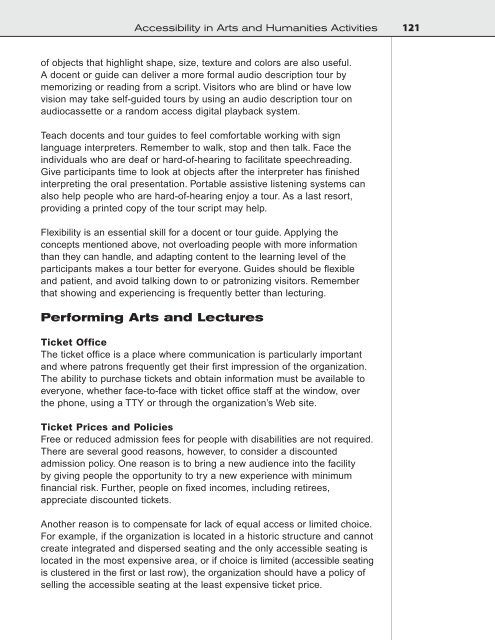Design for Accessibility: A Cultural Administrator's Handbook
Design for Accessibility: A Cultural Administrator's Handbook
Design for Accessibility: A Cultural Administrator's Handbook
You also want an ePaper? Increase the reach of your titles
YUMPU automatically turns print PDFs into web optimized ePapers that Google loves.
<strong>Accessibility</strong> in Arts and Humanities Activities 121<br />
of objects that highlight shape, size, texture and colors are also useful.<br />
A docent or guide can deliver a more <strong>for</strong>mal audio description tour by<br />
memorizing or reading from a script. Visitors who are blind or have low<br />
vision may take self-guided tours by using an audio description tour on<br />
audiocassette or a random access digital playback system.<br />
Teach docents and tour guides to feel com<strong>for</strong>table working with sign<br />
language interpreters. Remember to walk, stop and then talk. Face the<br />
individuals who are deaf or hard-of-hearing to facilitate speechreading.<br />
Give participants time to look at objects after the interpreter has finished<br />
interpreting the oral presentation. Portable assistive listening systems can<br />
also help people who are hard-of-hearing enjoy a tour. As a last resort,<br />
providing a printed copy of the tour script may help.<br />
Flexibility is an essential skill <strong>for</strong> a docent or tour guide. Applying the<br />
concepts mentioned above, not overloading people with more in<strong>for</strong>mation<br />
than they can handle, and adapting content to the learning level of the<br />
participants makes a tour better <strong>for</strong> everyone. Guides should be flexible<br />
and patient, and avoid talking down to or patronizing visitors. Remember<br />
that showing and experiencing is frequently better than lecturing.<br />
Per<strong>for</strong>ming Arts and Lectures<br />
Ticket Office<br />
The ticket office is a place where communication is particularly important<br />
and where patrons frequently get their first impression of the organization.<br />
The ability to purchase tickets and obtain in<strong>for</strong>mation must be available to<br />
everyone, whether face-to-face with ticket office staff at the window, over<br />
the phone, using a TTY or through the organization’s Web site.<br />
Ticket Prices and Policies<br />
Free or reduced admission fees <strong>for</strong> people with disabilities are not required.<br />
There are several good reasons, however, to consider a discounted<br />
admission policy. One reason is to bring a new audience into the facility<br />
by giving people the opportunity to try a new experience with minimum<br />
financial risk. Further, people on fixed incomes, including retirees,<br />
appreciate discounted tickets.<br />
Another reason is to compensate <strong>for</strong> lack of equal access or limited choice.<br />
For example, if the organization is located in a historic structure and cannot<br />
create integrated and dispersed seating and the only accessible seating is<br />
located in the most expensive area, or if choice is limited (accessible seating<br />
is clustered in the first or last row), the organization should have a policy of<br />
selling the accessible seating at the least expensive ticket price.


